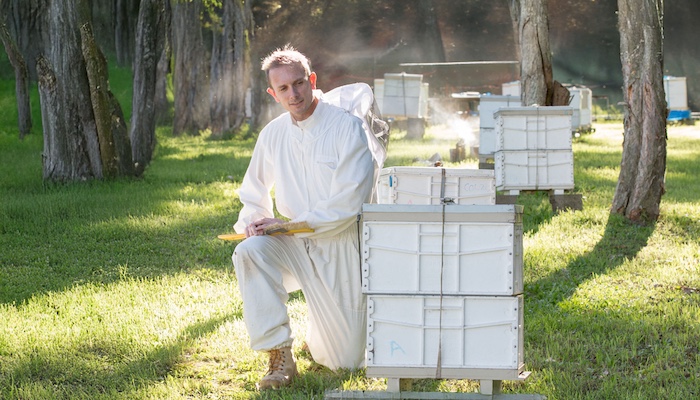Dust with metals (arsenic, cadmium, lead and nickel) above state and international benchmarks are falling daily onto inner-city Townsville playgrounds. This dust can now be traced to Mount Isa types of ore, exported through the Port of Townsville, a new study published this week in Science of the Total Environment by Professor Mark Taylor shows.
“At all playgrounds, at least once during our study, hand lead loading values exceeded the Government of Western Australia's 2011 clean-up value for lead (400 μg/m2) on surfaces accessible to children. Although the study sampled playgrounds, the hazard from contaminated dust will be present in houses, offices and schools in the neighbouring area,” says Professor Taylor.
“The similarity of the lead isotope composition of dust wipes to those of Mount Isa type ores confirms that the Port is the most likely source of surface dust contamination.”
The independent peer review and publication of the work counteracts criticisms by the Port who paid for an expert review of Professor Taylor and his team’s report last December for North Queensland Conservation Council.
The Science of the Total Environment article refutes the Port review’s suggestion that the method and approach were inappropriate and that the sources could be natural dusts or historical sources.
“It is inconceivable that historic or natural sources are contributing in any significant manner to contemporary dust depositions from winds that come from the direction of the Port,” said Professor Taylor. “In cases of contemporary environmental contamination problems, defenders of industrial pollution use a range of arguments to distract from the most obvious source and cause of the problem – the contamination is naturally occurring; it’s from legacy sources or the method is incorrect or non-standard. These can be dismantled with careful science, as is the case here.”
There are two likely primary sources of nickel in the contaminated dust:
“The community have long called for the city’s dust problem to be investigated and resolved. This study indicates that the precise cause of contamination at the Port must be identified, significantly reduced and preferably eliminated. Effective treatments must include covering the trains transporting the nickel ore to Queensland Nickel, fully enclosing all loading and unloading operations and checking the effectiveness of existing mitigation programmes,” says Professor Taylor.
Atmospherically deposited trace metals from bulk mineral concentrate port operations, Mark Patrick Taylor, Science of the Total Environment 2015. http://www.sciencedirect.com/science/article/pii/S0048969715001461?via=ihub
Acknowledgements
Funding for this study was provided by the North Queensland Conservation Council for the dustwipe analysis costs and for travel to present the findings of the study to stakeholders on the 4th December 2014. The Department of Environmental Sciences, Macquarie University, provided fieldwork travel costs in September 2014 and Macquarie University's PACE (Professional and Community Engagement) program provided travel support to Ali Maadh, Audrey Quicke, Emilia Rupsys and Paris Spellson, who undertook the majority of the field sampling.
“At all playgrounds, at least once during our study, hand lead loading values exceeded the Government of Western Australia's 2011 clean-up value for lead (400 μg/m2) on surfaces accessible to children. Although the study sampled playgrounds, the hazard from contaminated dust will be present in houses, offices and schools in the neighbouring area,” says Professor Taylor.
“The similarity of the lead isotope composition of dust wipes to those of Mount Isa type ores confirms that the Port is the most likely source of surface dust contamination.”
The independent peer review and publication of the work counteracts criticisms by the Port who paid for an expert review of Professor Taylor and his team’s report last December for North Queensland Conservation Council.
The Science of the Total Environment article refutes the Port review’s suggestion that the method and approach were inappropriate and that the sources could be natural dusts or historical sources.
“It is inconceivable that historic or natural sources are contributing in any significant manner to contemporary dust depositions from winds that come from the direction of the Port,” said Professor Taylor. “In cases of contemporary environmental contamination problems, defenders of industrial pollution use a range of arguments to distract from the most obvious source and cause of the problem – the contamination is naturally occurring; it’s from legacy sources or the method is incorrect or non-standard. These can be dismantled with careful science, as is the case here.”
There are two likely primary sources of nickel in the contaminated dust:
- the open air unloading of ore and
- its transport around Townsville in uncovered rail wagons to Queensland Nickel at Yabulu, 25 kilometres north-west of the city.
“The community have long called for the city’s dust problem to be investigated and resolved. This study indicates that the precise cause of contamination at the Port must be identified, significantly reduced and preferably eliminated. Effective treatments must include covering the trains transporting the nickel ore to Queensland Nickel, fully enclosing all loading and unloading operations and checking the effectiveness of existing mitigation programmes,” says Professor Taylor.
Atmospherically deposited trace metals from bulk mineral concentrate port operations, Mark Patrick Taylor, Science of the Total Environment 2015. http://www.sciencedirect.com/science/article/pii/S0048969715001461?via=ihub
Acknowledgements
Funding for this study was provided by the North Queensland Conservation Council for the dustwipe analysis costs and for travel to present the findings of the study to stakeholders on the 4th December 2014. The Department of Environmental Sciences, Macquarie University, provided fieldwork travel costs in September 2014 and Macquarie University's PACE (Professional and Community Engagement) program provided travel support to Ali Maadh, Audrey Quicke, Emilia Rupsys and Paris Spellson, who undertook the majority of the field sampling.



